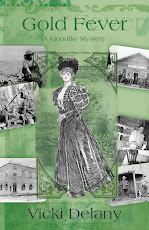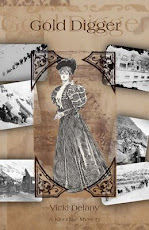Wasn’t that a party!
This past weekend saw the swan song of Bloody Words, the Canadian mystery
convention.
Yes, sad to say, Bloody Words is finished. For the simple
reason that the long-time organizers felt that they’d had enough (and who can
blame them) and no one else stepped up to the plate. Oh, there were plenty of
people saying that ‘someone’ should continue it. But no one volunteering to be
that ‘someone’.
 |
| At the Banquet |
Although rumours were swirling that a few people had their
heads together. We live in hope.
It was, however, a wonderful send-off.
 |
| Speechifying |
 |
| My mother was my guest at the AE gala |
 |
| Looking rather silly at Books with Legs |
I had the honour of being the Canadian guest of honour but
for me the excitement began the night before the convention itself with the
annual Arthur Ellis gala at which the awards for the best in Canadian crime
writing were handed out. I was the host
this year. We had a great dinner, a wonderful venue at the Arts and Letters
Club, and about a hundred very interesting guests. At dinner, I sat next to Michael Jecks, who
was the international guest of honour for Bloody Words, and I enjoyed getting
to know him.
My stint at being the host passed with no calamities, the
awards were handed out, nice speeches made, and everyone went off happily into
the night.
Bloody Words began on Friday and it was just a whirwind of
fun and activity. I went to lunch with
my publisher for Orca, Ruth Linka; met up with people I hadn’t seen in a while
such as Alex Brett and Michael Blair; and chatted with people I never tire of
seeing such as Linda Wiken and Mary Jane Maffini.
 |
| At the Orca Lunch with fellow Rapid Reads Writers |
The panels were all very interesting. I was
on one called 50 Shades of Cop, all about writing police novels, with John
McFetridge and Martin Walker, moderated by J.A. Menzies.
As Canadian guest of Honor, I was in the mystery café with
David Cole to talk about writing women in crime novels where Cathy Astolfo did
a great job of moderating. Also, Cheryl
Freedman interviewed me at length about my books and my writing career.
Gold Web: A Klondike Mystery, was up for a Bony Pete award for best light mystery. It didn't win, but heck it's an honour to be nominated. Right?
 |
| Michael Jecks, Cheryl Freedman, and Vicki Delany |
For pure fun, nothing beat Caro Soles’ Books with Legs or
the Saturday evening banquet at which we were asked to dress as a historical
mystery character. I sorta outdid myself
costume wise. As you can from the
attached pictures.



































